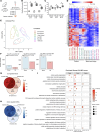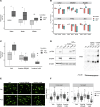Multiomics analysis unveils an inosine-sensitive DNA damage response in neurogenic bladder after spinal cord injury
- PMID: 40338665
- PMCID: PMC12220959
- DOI: 10.1172/jci.insight.180275
Multiomics analysis unveils an inosine-sensitive DNA damage response in neurogenic bladder after spinal cord injury
Abstract
Spinal cord injury (SCI) evokes profound dysfunction in hollow organs such as the urinary bladder and gut. Current treatments are limited by a lack of molecular data to inform novel therapeutic avenues. Previously, we showed that systemic treatment with the neuroprotective agent inosine improved bladder function following SCI in rats. Here, we applied integrated multi-omics analysis to explore molecular alterations in the bladder over time and their sensitivity to inosine following SCI. Canonical signaling pathways regulated by SCI included those associated with protein synthesis, neuroplasticity, wound healing, and neurotransmitter degradation. Upstream regulator and causal network analysis predicted multiple effectors of DNA damage response signaling following injury, including poly-ADP ribose phosphorylase-1 (PARP1). Markers of DNA damage (γH2AX, ATM/ATR substrates) and PARP activity were increased in bladder tissue following SCI and attenuated with inosine treatment. Inosine treatment also attenuated oxidative DNA damage in rat bladder cells in vitro. Proteomics analysis suggested that SCI induced changes in protein synthesis-, neuroplasticity-, and oxidative stress-associated pathways, a subset of which were shown in transcriptomics data to be inosine sensitive. These findings provide insights into the molecular landscape of the bladder following SCI and identify key inosine-sensitive pathways associated with injury.
Keywords: Bioinformatics; Cell biology; DNA repair; Muscle biology; Urology.
Figures









References
-
- Macarak EJ, et al. The collagens and their urologic implications. Adv Exp Med Biol. 1995;385:173–177. - PubMed
MeSH terms
Substances
Grants and funding
LinkOut - more resources
Full Text Sources
Medical
Research Materials
Miscellaneous

